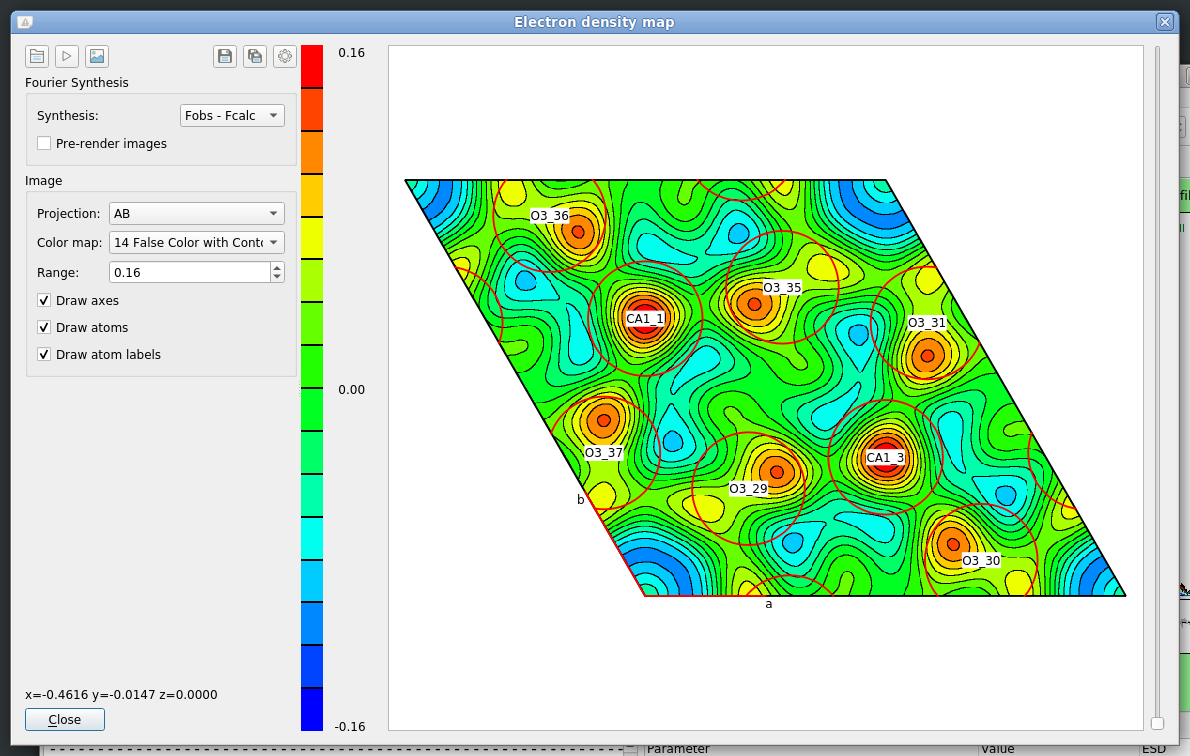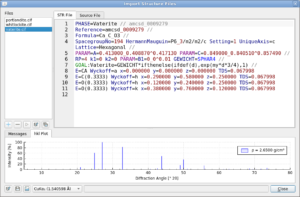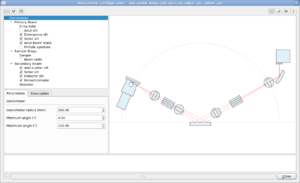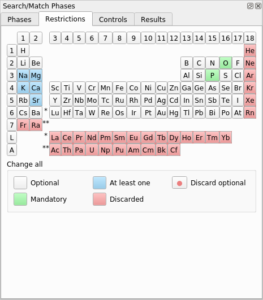Click here to see other posts about XRD
Our XRD interpretation includes: 1. Phase determination 2. Determination of diffracted planes 3- Calculation of crystalline size and microstrain 4- Whatever your request Its cost is only 12$ Payment Upon Completion Send your patterns...
- Profex
What is Profex?
Profex is a graphical user interface for Rietveld refinement of powder X-ray diffraction data with the program BGMN. It provides a large number of convenience features and facilitates the use of the BGMN Rietveld backend in many ways.

- Various options and output formats to create publication-quality graphs
- Main window
- Display hkl line positions from the internal reference structure database
- Powerful text editors support syntax highlighting and various convenience features
- A context help provides descriptions of all refinement parameters
- After the refinement, results are summarized (bottom right)
- Show the refined chemical composition (bottom right)
- A powerful search-match module for phase identification
- CIF / XML import editor to convert CIF or ICDD XML structure files to the native STR format
 Compute electron density maps (Fobs, Fcalc, or difference fourier maps)
Compute electron density maps (Fobs, Fcalc, or difference fourier maps)- Graphical instrument editor to edit the fundamental parameters
- Generic non-linear curve fitting module
- Various options and output formats to create publication-quality graphs
- Main window
Key features
- Support for a variety of raw data formats, including all major instrument manufacturers (Bruker / Siemens, PANalytical / Philips, Rigaku, Seifert / GE, and generic text formats)
- Export of diffraction patterns to various text formats (ASCII, Gnuplot scripts, Fityk scripts), pixel graphics (PNG), and vector graphics (SVG)
- Batch conversion of raw data scans
- Automatic control file creation and output file name management
- Conversion of CIF and ICDD PDF-4+ XML structure files to BGMN structure files
- Export of refined crystal structures to CIF and Castep CELL format
- Internal database for crystal structure files, instrument configuration files, and predefined refinement presets
- Computation of chemical composition from refined crystal structures
- Batch refinement
- Export of refinement results to spreadsheet files (CSV format)
- Context help for BGMN variables
- Syntax highlighting
- Enhanced text editors for structure and control file management and editing
- Generic support for FullProf.2k as an alternative Rietveld backend to BGMN
- And many more…
Profex runs on Windows, Linux, and Mac OS X operating systems and is available as free software licensed under the GNU General Public License (GPL) version 2 or any later version.

Video tutorials
August 12, 2020. Check out our brand new YouTube channel Profex Tutorials. We will periodically publish new tutorials for selected topics. The first episode explains installation and setup of Profex on three different platforms:https://www.youtube.com/embed/vaWBjTNWG7U?feature=oembed
Profex 4.2 released
August 05, 2020. Profex, our software for Rietveld refinement of powder X-ray diffraction data (XRD), continues to gain popularity and is now established worldwide in the material and earth sciences communities. With the new version 4.2, it has received some long-awaited features that make it easier to use for new and experienced users. As always, Profex remains available as open-source software and is free for academic and commercial use. Visit the What’s new page for an overview of the new features, and download the latest version for Windows, Mac OS or Linux from the Download page.
Feature highlights in version 4.2

Import of CIF structure files has further been improved. Most CIF files require no user input anymore. Wyckoff symbols are determined automatically.
Creating instrument configurations has always been a major obstacle for new users. A brand new graphical instrument editor is easier and more attractive to use. It guides users through the process of creating configuration files for their own devices.


The search-match module for phase identification was introduced with Profex 4.0. With version 4.2, it supports chemical restrictions, which gives more control over the search process and improves the match rate and processing speed
See https://www.profex-xrd.org/

2. OpenXRD
OpenXRD is a program for the analysis of X-ray diffraction data.It will comprise scan treatment (background substraction, peak hunting) as well as mineral identification. OpenXRD will read almost any available data format. OpenXRD is free software and published under the GPL.
We will try to establish a free file with mineral data, fed by scientists and given back to scientists. OpenXRD will be available for Linux/Unix, Windows, and, perhaps Macintosh computers.
Released under GNU General Public License version 2.0 (GPLv2)
OpenXRD is a free software application from the Other subcategory, part of the Graphic Apps category. The app is currently available in English and it was last updated on 2001-12-27. The program can be installed on All 32-bit MS Windows (95/98/NT/2000/XP) All POSIX (Linux/BSD/UNIX-like OSes) OS X Linux.
OpenXRD (version ) is available for download from our website. Just click the green Download button above to start. Until now the program was downloaded 13911 times. We already checked that the download link to be safe, however for your own protection we recommend that you scan the downloaded software with your antivirus.
See: https://openxrd.soft112.com/
3. FullProf
What is FullProf?
The FullProf program has been mainly developed for Rietveld analysis (structure profile refinement) of neutron (constant wavelength, time of flight, nuclear and magnetic scattering) or X-ray powder diffraction data collected at constant or variable step in scattering angle 2theta. The program can be also used as a Profile Matching (or pattern decomposition using Le Bail method) tool, without the knowledge of the structure. Single crystal refinement can also be performed alone or in combination with powder data. Time of flight (TOF) neutron data analysis is also available. Energy dispersive X-ray data can also be treated but only for profile matching.
Features:
- X-ray diffraction data: laboratory and synchrotron sources
- X-ray diffraction data: laboratory and synchrotron sources
- One or two wavelengths (eventually with different profile parameters)
- Scattering variables: 2theta (in degrees), TOF (in microseconds), energy (in KeV)
- Background: fixed, refinable points or polynomial coefficients, Fourier filtering
- Choice of peak shape for each phase: Gaussian, Lorentzian, modified Lorentzian, pseudo-Voigt, Pearson-VII, Thompson-Cox-Hastings (TCH) pseudo-Voigt, numerical, split pseudo-Voigt, convolution of a double exponential with a TCH pseudo-Voigt for TOF
- Multi-phase (up to 16 phases)
- Preferred orientation: two functions available
- Absorption correction for different geometries. Micro-absorption for Bragg-Brentano set-up
- Choice between three weighting scheme: standard least-square, maximum likelihood and unit weights
- Choice between automatic generation of hkl and/or symmetry operators and file given by user
- Magnetic structure refinement (crystallographic and spherical representation of the magnetic moment). Two methods: describing the magnetic structure in the magnetic unit cell or making use of the propagation vectors using the crystallographic unit cell. This second method is necessary for incommensurate magnetic structures
- Automatic generation of reflections for an incommensurate structure with up to 24 propagation vectors. Refinement of propagation vectors components in reciprocal lattice units
- hkl-dependence of FWHM for strain and size effects
- hkl-dependence of the position shifts of Bragg reflections for special kinds of defects
- Profile Matching: the full profile can be adjusted without prior knowledge of the structure (needs only good starting cell parameters and profile parameters)
- Quantitative analysis withour need of structure factor calculations
- Chemical (distances and angles) and magnetic (magnetic moments) slack constraints. They can be generated automatically by the program
- The instrumental resolution function (Voigt function) may be supplied in a file. A microstructural analysis is then performed
- Form factor refinement of complex objects (plastic crystals)
- Structural or magnetic model could be supplied by an external subroutine for special purposes (rigid bodies TLS is the default, polymers, small angle scattering of amphifilic crystals, description of incommensurate structure in real direct space, etc)
- Single crystal data or integrated intensities can be used as observations (alone or in combination with a powder profile)
- Neutron (or X-ray) powder patterns can be mixed with integrated intensities of X-ray (or neutron) for single crystal or powder data
- Full multi-pattern capabilities. The user may mix several powder diffraction patterns (eventually heterogeneous: X-rays, TOF neutrons, etc.) with total control of the weighting scheme
- Montecarlo/Simulated Annealing algorithms have been introduced to search the starting parameters of a structural problem using integrated intensity data
See: https://www.ill.eu/sites/fullprof/php/programs.html

4. PowDLL
PowDLL is a .NET dynamic link library used for the interconversion procedure between variable formats of Powder X-Ray files. The DLL is capable of handling the most common file formats (binary and ASCII). The library can be used as a reusable component with any .NET language or as a standalone utility.
See: http://users.uoi.gr/nkourkou/powdll/
5. Software Ic
The software packages currently developed at IC are:
- Sir: a widely used package for the solution and refinement of macro and small molecules using either X-ray or electron diffraction single-crystal data.
- EXPO2014/EXPO2013: an integrated package for the indexation of a powder diffraction pattern, the extraction of integrated intensities, the space group determination, the crystal structure solution viaDirect Methods and/or by a direct-space approach, and the structure refinement by the Rietveld technique.
- QualX2.0/QualX: a computer program for phase identification using powder diffraction data.
- Quanto: a Rietveld program for quantitative phase analysis of polycrystalline mixtures from powder diffraction data.
- SunBIM: a suite of programs for the supra- and sub-molecular X-ray imaging of nano and bio materials with SAXS, WAXS, GISAXS and GIWAXS techniques
- RootProf: An interactive, general purpose tool for processing unidimensional profiles with specific applications to X-ray diffraction measurements
- OChemdb: an on-line portal, using an appropriately designed database of already solved crystal structures, for searching and analysing crystal-chemical information of organic, metal-organic and inorganic structures, and providing statistics on desired bond distances, bond angles, torsion angles, and space groups.
The software is free for academic and non-profit research institutions, while it requires the payment of a license fee to commercial users.
To download the software packages, academic and no-profit users must first register to the web site, choosing the software packages of their interest and accepting all the terms and conditions of the on-line Academic License Agreement. After completing the registration, users will receive a confirmation e-mail and will be allowed tologin to download the selected packages.
Registered users can download freely the previous versions of our packages (such as Sir97, Sir2004, EXPO2004, EXPO2009, EXPO2013 and QualX) for non-commercial use from the Old Software section of the web site.
Commercial users must fill the Order Form and send it by email or fax to our office, together with a signed copy of the Commercial License Agreement.
The license covers the use of all the requested programs under all the supported operating systems for an unlimited time on an unlimited number of computers.
See: http://www.ba.ic.cnr.it/softwareic/

X-ray diffraction, abbreviated as XRD, is an old and well-known technique for studying the structure and properties of crystals. The basis of the XRD method is single-color X-ray diffraction by atoms of a substance. Diffraction generally occurs when light strikes an obstacle. When it hits an obstacle, the light beam either bends and propagates or passes through tiny pores on the obstacle. The diffraction phenomenon is visible for all electromagnetic rays, including X-rays. Interference between the X-ray electric vector and the electrons of the material through which the beam passes can be constructive or destructive. In constructive interference, the X-ray diffraction pattern is characterized by a pattern of atomic arrangement in a regular crystal structure. In fact, when an X-ray is shone on a crystal, its diffraction occurs according to the structural characteristic pattern of the crystal.
Bragg’s Law
Due to the regular structure in a crystal, it can be assumed to be regular plates with specified intervals. Diffraction occurs because the distance between the regular layers of a crystal is close to the X-ray wavelength. The X-ray strikes the angle θ with the surface, causing part of the initial beam to propagate at the same angle θ and the other part to enter the inner plates of the crystal. This process is repeated for many pages of a crystal. The distance traveled by X-rays in contact with surface atoms is less than the distance traveled in contact with the inner layer of the crystal. The distance traveled depends on the distance between the two layers and the angle of X-ray radiation.
X-ray diffraction – XRD – analium
Figure 1 X-ray collision and its diffraction method in XRD method
Figure 1 shows that the difference in path traveled between the first and second layers is equal to:
BG = BC = dSinθ (1)
Constructive diffraction occurs when the difference in the length of the X-ray path is an exact multiple of the wavelength. Therefore, for the total distance traveled, it is equal to:
(2) nλ = 2dSinθ
This equation is known as the Bragg relation. In this relation λ the wavelength of the source d is the distance between the crystal plates and θ is the angle of incidence and n is an integer. Note that based on this equation, the X-ray will only be reflected at specific angles obtained from the rearrangement of Equation 1:
(3) Sinθ = nλ / 2dAn XRD spectrum is obtained by plotting the intensity in θ. By changing θ and knowing the wavelength of the source λ, d is obtained at any moment.
XRD device
Similar to many XRD component analyzers, they include a source, a wavelength selector, a sample location, a detector, and a signal converter. Figure 2 shows an overview of an X-ray diffraction device (XRD).
X-ray diffraction device (XRD) – analium
Figure 2 Overview of an X-ray diffraction device (XRD)
X-ray tubes with tungsten filament are commonly used as sources. Source intensity can be adjusted by adjusting the current flowing through it. The beam wavelength can also be controlled by applying applied voltage control.
A monochromator or filter is used to create a monochromatic beam. A variety of scintillation and semiconductor gas-filled detectors are used in XRD devices.
Preparation of XRD samples
The sample must be well ground to obtain a homogeneous powder from the crystalline sample. In this case, it is possible to place a large number of crystalline particles in the desired direction and in accordance with the Bragg equation. The samples are mixed with a suitable adhesive and then molded.
Crystallization is a very important step in the preparation of XRD samples and requires special skills and expertise.
In powder X-ray diffraction, the diffraction pattern is obtained from the powder form of the sample. XRD powder is usually lighter and simpler than crystalline diffraction. Because in powder form, there is no need to prepare single crystal. In the powder method, the mass pattern (bulk) of the sample is also obtained.
XRD Analysis Tips
The sample must have a crystalline structure.
Has little accuracy in quantifying phases (phases with values less than 5% are not detected).
In qualitative analysis, the element does not perform well.
The method is fast and powerful and with convenient access.
XRD Application Background
Determining the crystal structure and accurate measurement of lattice parameters
Determining fuzzy diagrams
Chemical identification and analysis
Determining the quality and direction of plates in single crystals
